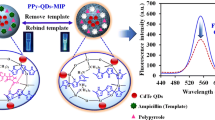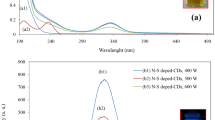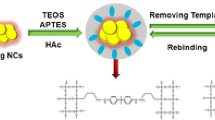Abstract
A new fluorescent probe based on graphitic carbon nitride (g-C3N4) combined with molecularly imprinted silica was successfully fabricated and used to selectively recognize chlortetracycline (CTC). The g-C3N4 used in this study has the characteristics of low toxicity and high chemical stability. This synthetic composite was characterized by transmission electron microscopy, Fourier transform infrared spectroscopy, UV spectroscopy, X-ray diffraction, and fluorescence spectroscopy. The material was used to detect CTC by the fluorescence quenching technique. The fluorescence quenching was due to g-C3N4 and the benzene ring of CTC through π–π electron donor–acceptor interaction and electrostatic force. Hydrogen bonds formed between CTC and 3-aminopropyltriethoxysilane during the polymerization process. Eventually, a considerable amount of selective recognition holes were formed in the composite material and could specifically recognize the template molecule CTC. In addition, the probe strategy was successfully applied to milk analysis, and the recoveries ranged from 90.1% to 95.7%, with relative standard deviations of 1.8–2.8%; the detection limit for CTC was 8 ng mL-1. The results indicate that this method combined the sensitivity of fluorescence detection with the excellent selectivity of a molecularly imprinted polymer. The new material can be widely used in the detection of dairy products.

Schematic of synthesis of the MIP-capped g-C3N4 by sol-gel reaction








Similar content being viewed by others
References
Tong L, Qin L, Xie C, Liu H, Wang Y, Guan C, et al. Distribution of antibiotics in alluvial sediment near animal breeding areas at the Jianghan Plain, central China. Chemosphere. 2017;186:100–7.
Wang HX, Ren LS, Yu X, Hu J, Chen Y, He GS, et al. Antibiotic residues in meat, milk and aquatic products in Shanghai and human exposure assessment. Food Control. 2017;80:217–25.
Wang R, Chen M, Feng F, Zhang J, Sui Q, Tong J, et al. Effects of chlorotetracycline and copper on tetracyclines and copper resistance genes and microbial community during swine manure anaerobic digestion. Bioresour Technol. 2017;238:57–69.
Chiesa LM, Nobile M, Panseri S, Arioli F. Antibiotic use in heavy pigs: comparison between urine and muscle samples from food chain animals analysed by HPLC-MS/MS. Food Chem. 2017;235:111–8.
Guo ZY, Gai PP, Duan J, Zhang HN, Wang S. Tetracycline selective electrode based on molecularly imprinted polymer particles. Chin Chem Lett. 2010;21:1235–8.
Muriuki FK, Ogara WO, Njeruh FM, Mitema ES. Tetracycline residue levels in cattle meat from Nairobi slaughter house in Kenya. J Vet Sci. 2001;2:97–101.
Zhang YD, Zheng N, Han RW, Zheng BQ, Yu ZN, Li SL, et al. Occurrence of tetracyclines, sulfonamides, sulfamethazine and quinolones in pasteurized milk and UHT milk in China's market. Food Control. 2014;36:238–42.
Long CJ, Deng BY, Sun SJ, Meng S. Simultaneous determination of chlorotetracycline, ampicillin and sarafloxacin in milk using capillary electrophoresis with electrochemiluminescence detection. Food Addit Contam Part A. 2017;34:24–31.
Szlyk E, Kowalczyk-Marzec A, Koter I. Determination of Tetracyclines by near-infrared (NIR) spectroscopy and partial least-squares (PLS) regression method. Chem Anal. 2007;52:605–17.
Phiroonsoontorn N, Sansuk S, Santaladchaiyakit Y, Srijaranai S. The use of dissolvable layered double hydroxide components in an in situ solid-phase extraction for chromatographic determination of tetracyclines in water and milk samples. J Chromatogr A. 2017;1519:38–44.
Liu H, Chen X, Mu L, Wang J, Sun B. Application of quantum dot–molecularly imprinted polymer core–shell particles sensitized with graphene for optosensing of N ε-carboxymethyllysine in dairy products. J Agric Food Chem. 2016;64:4801–6.
Ganiga M, Cyriac J. An ascorbic acid sensor based on cadmium sulphide quantum dots. Anal Bioanal Chem. 2016;408:3699–706.
Ren XH, Chen LG. Preparation of molecularly imprinted polymer coated quantum dots to detect nicosulfuron in water samples. Anal Bioanal Chem. 2015;407:8087–95.
Sheng Z, Chen LG. Switch-on fluorescent strategy based on crystal violet-functionalized CdTe quantum dots for detecting L-cysteine and glutathione in water and urine. Anal Bioanal Chem. 2017;409:6081–90.
Mo Z, Xu H, Chen ZG, She XJ, Song YH, Wu JJ, et al. Self-assembled synthesis of defect-engineered graphitic carbon nitride nanotubes for efficient conversion of solar energy. Appl Catal B Environ. 2018;225:154–61.
Song XP, Yang Q, Jiang XH, Yin MY, Zhou LM. Porous graphitic carbon nitride nanosheets prepared under self-producing atmosphere for highly improved photocatalytic activity. Appl Catal B Environ. 2017;217:322–30.
Tang Y, Su Y, Yang N, Zhang L, Lv Y. Carbon nitride quantum dots: a novel chemiluminescence system for selective detection of free chlorine in water. Anal Chem. 2014;86:4528–35.
Wang HY, Lu QJ, Li MX, Li H, Liu YL, Li HT, et al. Electrochemically prepared oxygen and sulfur co-doped graphitic carbon nitride quantum dots for fluorescence determination of copper and silver ions and biothiols. Anal Chim Acta. 2018;1027:121–9.
Li YH, Cai JB, Liu FJ, Yu HW, Lin F, Yang H, et al. Highly crystalline graphitic carbon nitride quantum dots as a fluorescent probe for detection of Fe (III) via an innner filter effect. Microchim Acta. 2018;185:134.
Yin Y, Zhang YM, Gao TL, Yao T, Han JC, Han ZB, et al. One-pot evaporation–condensation strategy for green synthesis of carbon nitride quantum dots: an efficient fluorescent probe for ion detection and bioimaging. Mater Chem Phys. 2017;194:293–301.
Rong MC, Lin LP, Song XH, Zhao TT, Zhong YX, Yan JW, et al. A label-free fluorescence sensing approach for selective and sensitive detection of 2,4,6-trinitrophenol (TNP) in aqueous solution using graphitic carbon nitride nanosheets. Anal Chem. 2015;87:1288–96.
Chen LG, Zhang XP, Sun L, Xu Y, Zeng QL, Wang H, et al. Fast and selective extraction of sulfonamides from honey based on magnetic molecularly imprinted polymer. J Agric Food Chem. 2009;57:10073–80.
Hu YL, Pan JL, Zhang KG, Lian HX, Li GK. Novel applications of molecularly-imprinted polymers in sample preparation. Trends Anal Chem. 2013;43:37–52.
Chen LX, Xu SF, Li JH. Recent advances in molecular imprinting technology: current status, challenges and highlighted applications. Chem Soc Rev. 2011;40:2922–42.
Chen LG, Li B. Magnetic molecularly imprinted polymer extraction of chloramphenicol from honey. Food Chem. 2013;141:23–8.
Liu GY, Yang X, Li TF, She YX, Wang SS, Wang J, et al. Preparation of a magnetic molecularly imprinted polymer using g-C3N4-Fe3O4 for atrazine adsorption. Mater Lett. 2015;160:472–5.
Li JS, Wang H, Guo ZK, Wang YG, Ma HM, Ren X, et al. A "turn-off" fluorescent biosensor for the detection of mercury (II) based on graphite carbon nitride. Talanta. 2017;162:46–51.
Yang XM, Zhu SS, Dou Y, Zhuo Y, Luo YW, Feng YJ. Novel and remarkable enhanced-fluorescence system based on gold nanoclusters for detection of tetracycline. Talanta. 2014;122:36–42.
Hatamie A, Marahel F, Sharifat A. Green synthesis of graphitic carbon nitride nanosheet (g-C3N4) and using it as a label-free fluorosensor for detection of metronidazole via quenching of the fluorescence. Talanta. 2018;176:518–25.
Valverde RS, García MDG, Galera MM, Goicoechea HC. Determination of tetracyclines in surface water by partial least squares using multivariate calibration transfer to correct the effect of solid phase preconcentration in photochemically induced fluorescence signals. Anal Chim Acta. 2006;562:85–93.
Li ZQ, Qi MY, Tu CY, Wang WP, Chen JR, Wang AJ. Highly efficient removal of chlorotetracycline from aqueous solution using graphene oxide/TiO2 composite: properties and mechanism. Appl Surf Sci. 2017;425:765–75.
Zhang XH, Gao RQ, Li DP, Yin HY, Zhang JL, Cao HY, et al. Study on interaction between 5-bromo-4-thio-2′-deoxyuridine and human serum albumin by spectroscopy and molecular docking. Spectrochim Acta A. 2015;136:1775–81.
Tu RY, Liu BH, Wang ZY, Gao DM, Wang F, Fang QL, et al. Amine-Capped ZnS-Mn2+ nanocrystals for fluorescence detection of trace TNT explosive. Anal Chem. 2008;80:3458–65.
Quayle OR. The parachors of organic compounds. An interpretation and catalogue. Chem Rev. 1953;53:439–589.
Li XW, Li CY, Chen LG. Preparation of multifunctional magnetic-fluorescent nanocomposites for analysis of tetracycline hydrochloride. New J Chem. 2015;39:9976–82.
Bekale L, Agudelo D, Tajmirriahi HA. Effect of polymer molecular weight on chitosan-protein interaction. Colloids Surf B: Biointerfaces. 2015;125:309–17.
Ross PD, Subramanian S. Thermodynamics of protein association reactions: forces contributing to stability. Biochemistry. 1981;20:3096–102.
Schneider MJ, Darwish AM, Freeman DW. Simultaneous multiresidue determination of tetracyclines and fluoroquinolones in catfish muscle using high performance liquid chromatography with fluorescence detection. Anal Chim Acta. 2007;586:269–74.
Mónicacecilia VM, Felixguillermo RR, Susanne R. Multiresidue determination of tetracyclines, sulphonamides and chloramphenicol in bovine milk using HPLC-DAD. Food Chem. 2009;117:545–52.
Koesukwiwat U, Jayanta S, Leepipatpiboon N. Validation of a liquid chromatography-mass spectrometry multi-residue method for the simultaneous determination of sulfonamides, tetracyclines, and pyrimethamine in milk. J Chromatogr A. 2007;1140:147–56.
Yang CY, Xiong Y, He C, Zhang ZJ. Molecularly imprinted on-line solid-phase extraction combined with flow injection chemiluminescence for determination of chlortetracycline. Chin J Chem. 2007;24:273–7.
Jing T, Niu JW, Xia H, Dai Q, Zheng HY, Hao QL, et al. Online coupling of molecularly imprinted solid-phase extraction to HPLC for determination of trace tetracycline antibiotic residues in egg samples. J Sep Sci. 2011;34:1469–76.
Qu GR, Zheng SL, Liu YM, Xie W, Wu AB, Zhang DB. Metal ion mediated synthesis of molecularly imprinted polymers targeting tetracyclines in aqueous samples. J Chromatogr B. 2009;877:3187–93.
Acknowledgements
This work was supported by the Fundamental Research Funds for the Central Universities (no. 2572017EB08), the Natural Science Foundation of Heilongjiang Province (JJ2018ZR0081), Harbin Science and Technology Innovation Talent Research Special Funds (2016RAQXJ151), and the Open Project of the State Key Laboratory of Urban Water Resource and Environment, Harbin Institute of Technology (no. ES201607).
Author information
Authors and Affiliations
Corresponding authors
Ethics declarations
Conflict of interest
The authors declare that they have no competing interests.
Electronic supplementary material
ESM 1
(PDF 343 kb)
Rights and permissions
About this article
Cite this article
Xu, S., Ding, J. & Chen, L. A fluorescent material for the detection of chlortetracycline based on molecularly imprinted silica–graphitic carbon nitride composite. Anal Bioanal Chem 410, 7103–7112 (2018). https://doi.org/10.1007/s00216-018-1310-5
Received:
Revised:
Accepted:
Published:
Issue Date:
DOI: https://doi.org/10.1007/s00216-018-1310-5




